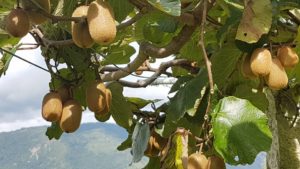The Kiwifruit farming in Kenya by majority of small farmers is a very encouraging attempt. We can see that Kenya has all the possibilities in the world as the climate and altitudes are very suitable for its farming which are helpful to be a major force in Kiwifruit production. We have huge exportable market of it. Reliable supply chain, guarantee of quality, competitive pricing and a sound storage system that could help kiwifruit to grow.
Also read: Macadamia nuts farming: How to get most returns
How to Plant Kiwifruit in your farm
[caption id="attachment_1043" align="alignright" width="300"] Kiwifruit farm in kenya[/caption]
Kiwifruit farm in kenya[/caption]
Find a good spot in your farm for your kiwifruit. Make sure conditions there are suitable.
- You will need adequate space for your kiwifruit plants to grow.
- Most kiwifruit plants grow best in either full sun or light shade.
- Kiwifruit generally need slightly acidic soil that has a pH between 6.0 and 6.5. If your soil is too alkaline, you can try to acidify it to make conditions right for growing kiwifruit.
- The soil must be moist but well-drained
Build a sturdy trellis for your plants. Remember that kiwifruits are vine plants that can grow up to 30 feet long and weigh a fair amount. Like other vines, they grow best across vertical structures that provide support and greater access to light.
- Kiwifruit vines can grow on most types of trellises, gazebos, and fences.
- Commercial kiwifruit growers use six-foot-high wire trellises with T-bars spaced 15 to 20 feet apart
Transplant the young plants. Transplanting kiwifruit plants is largely the same as other types of plants. The major difference is that you must space your plants so that each is at the base of its own support structure. Simply dig a hole for each plant that is a little bigger than their current pots. Carefully lift each plant out of its pot, including the roots and the dirt they cling to, and place the roots into the holes you just dug. Finish by filling in the edges of the hole with loose dirt.
- Try to disturb the roots as little as possible to avoid shock.
- If you plant to grow fruit, keep as many plants as you have room for. Once they flower, which can take up to five years, you can identify the male and female plants and cull the extras.
Maintaining Kiwifruit
Protect your kiwifruit from animals. Even if all other conditions are perfect, your plants may be destroyed by various pests. Kiwifruit plants will be especially vulnerable until they have fully matured.
- The leaves of kiwifruit plants can sometimes attract deer. Keep your young plants safe by keeping domestic animals out of your yard with either a fence around it or chicken wire surrounding your plants.
- Cats respond to kiwi leaves similarly to catnip. If there are outdoor cats in your area, take measures to keep them out of your garden. Example strategies include building a fence, putting chicken wire around each of your plants, and spraying with repellents.
- Unlike many other commercial fruit-bearing plants, kiwifruit do not have many insect enemies, so regular pesticide use is usually unnecessary.
Tie shoots to supports. As your kiwifruit plant grows, it will begin to send out shoots. You will need to train these shoots to grow on the support by wiring the vines to the trellis. This will ensure that the plant will grow a strong "trunk" section.
Prune your plants regularly. You should prune your kiwifruit plants once a year. Trim excess canes (vines that have grown a bark-like skin) and any lateral shoots not supportable by its trellis. Lateral shoots are branches that go off to the sides. Your kiwifruit vines will not be able to support the weight of such shoots on their own until they've reached the top of your trellis (when using the T-support system). Once the vines reach the top of the trellis, they will be able to grow more horizontally across it.
- The optimal time for pruning female plants is late winter while the plant is dormant.
- Male plants can be pruned sooner, right after flowering.
Cull the male plants. Kiwi plants will usually flower within 3-4 years of planting. When this happens, you can identify the male plants by the bright yellow, pollen-covered anthers in the flower's center. The female plants have sticky stalks (stigma) in the center instead, and white ovaries at the base of the flower.
Since only the female kiwi vines produce fruit, you'll want one male plant to pollinate every 8 or 9 female plants, rather than an even split between the two. Remove the excess males and space the survivors an equal distance apart among the female vines
Harvesting kiwifruit
Harvest your fruit once it's ripe. After a few years (or even that same year for hardy and super-hardy kiwi), your plants should start producing fruit. Yields may start out small but typically increase every year as the plant matures.
- Kiwifruit usually ripens in September and October. If frosts typically happen by then in your area, you will need to harvest the fruit before it's ripe and let it finish ripening under refrigeration.
- Snap kiwifruit off at the stalk when their skin begins to change color (to brown for common kiwifruit). Another way to check for harvest-readiness is to look for black seeds in a sample fruit
Internationally Kiwifruit is considered as one of the best and high valued fruits. Currently in Kenya one piece of a kiwifruit costs Ksh100. Let's think and work in its farming and production. Book your seedlings today!











